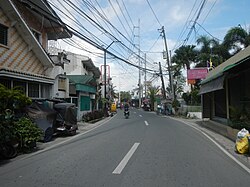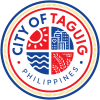Ibayo-Tipas
- View a machine-translated version of the Tagalog article.
- Machine translation, like DeepL or Google Translate, is a useful starting point for translations, but translators must revise errors as necessary and confirm that the translation is accurate, rather than simply copy-pasting machine-translated text into the English Wikipedia.
- Do not translate text that appears unreliable or low-quality. If possible, verify the text with references provided in the foreign-language article.
- You must provide copyright attribution in the edit summary accompanying your translation by providing an interlanguage link to the source of your translation. A model attribution edit summary is
Content in this edit is translated from the existing Tagalog Wikipedia article at [[:tl:Calzada Tipas, Taguig]]; see its history for attribution. - You may also add the template
{{Translated|tl|Calzada Tipas, Taguig}}to the talk page. - For more guidance, see Wikipedia:Translation.
Ibayo-Tipas Ibayo Tipas | |
|---|---|
Barangay | |
 F. Manalo Street | |
 Seal | |
| 14°31′39.76″N 121°4′35.85″E / 14.5277111°N 121.0766250°E / 14.5277111; 121.0766250 | |
| Country | Philippines |
| Region | National Capital Region |
| City | Taguig |
| District | 1st Legislative district of Taguig |
| Ibayo Tipas | July 15, 1971 |
| Government | |
| • Type | Barangay |
| • Barangay Captain | Willy Flores |
| Population (2020) | |
| • Total | 25,808 |
| Time zone | UTC+8 (PST) |
| Postal Code | 1637 |
| Area code | 02 |
| Website | https://www.facebook.com/barangayibayotipas/ |
Ibayo-Tipas, also known as Ibayo Tipas,is one of the 38 barangays of Taguig, Metro Manila in the Philippines.
Etymology
The first part of the barangay's name, Ibayo, comes from Tagalog for "further" or "other side". On the other hand, the second part, Tipas, comes from Tagalog tinagpas or tiga-gapas, which means "to cut" or "to break", representing the traditional practice of farmers cutting through rice crops during harvest.[1]
History
Through Municipal Resolution No. 51 of the Taguig Municipal Council on July 15, 1971, the old Nayon of Tipas was divided into 4 Barrios, namely: Calzada Tipas, Palingon Tipas, Ligid Tipas, and Ibayo Tipas.[2] It was converted into barangay in 1974, by virtue of Presidential Decree No. 557.[3]
On the book of Sir John Bowring (1792-1872), an English Diplomat, "A visit to the Philippine Islands", it was mentioned that Mabato Creek is a natural Thermal Bath.[4]
Geography
Ibayo Tipas is bounded on the borth by Mabato Creek, Manunuso Street, and Barangay Kalawaan, Pasig; on the east by Barangay Napindan; to the south by Laguna de Bay; and on the west by Tipas River and barangays Ligid Tipas and Palingon Tipas.
References
- ^ "Tipas tales worth telling". The Urban Roamer. October 19, 2020. Retrieved February 4, 2024.
- ^ A gift of faith, 400 years. Quadricentennial (1587-1987) St. Anne Parish Tagig, Metro Manila; commemorative book page 57, circa 1987.
- ^ Presidential Decree No. 557 (September 21, 1974), Declaring all barrios in the Philippines as barangays, and for other purposes, Official Gazette of the Republic of the Philippines, retrieved June 16, 2023
- ^ Bowring, John (2005). A visit to the Philippine Islands.
- v
- t
- e
- Historical markers
- Mayor
- People
- Public education
- Skyscrapers
- Tourism
- Transportation

- Bagumbayan
- Bambang
- Calzada
- Cembo
- Central Bicutan
- Central Signal Village
- Comembo
- East Rembo
- Fort Bonifacio
- Hagonoy
- Ibayo-Tipas
- Katuparan
- Ligid-Tipas
- Lower Bicutan
- Maharlika Village
- Napindan
- New Lower Bicutan
- North Daang Hari
- North Signal Village
- Palingon Tipas
- Pembo
- Pinagsama
- Pitogo
- Post Proper Northside
- Post Proper Southside
- Rizal
- San Miguel
- Santa Ana
- South Cembo
- South Daang Hari
- South Signal Village
- Tanyag
- Tuktukan
- Ususan
- Upper Bicutan
- Wawa
- Western Bicutan
- West Rembo
| Pateros–Taguig |
|
|---|---|
| Taguig |
|
- Metro Manila
- Philippines
 Category
Category
This article about a location in Metropolitan Manila (NCR) is a stub. You can help Wikipedia by expanding it. |
- v
- t
- e














